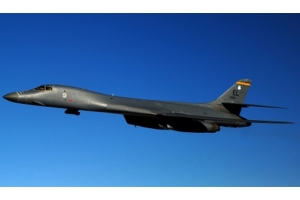It may be a small piece of a massive aircraft, but the B-1B lower rudder is essential.
The B-1B Lancer aircraft became operational for use in 1986, and sustaining it well into this decade is vital to Air Force operational readiness. The lower rudder is an integral part of a split rudder control system that provides structural support and control as the aircraft flies at high speeds. However, the current manufacturing process for the lower rudder piece is complex and expensive.
Researchers at the University of Oklahoma are assisting the Oklahoma City Air Logistics Complex, located at Tinker Air Force Base in Midwest City, OK, to re-engineer this small component with an outsized impact.
“The B-1B lower rudder re-engineering project at the University of Oklahoma has the potential to save the Air Force millions of dollars over the aircraft’s life cycle,” said ret. Lt. Gen. Gene Kirkland, executive director of the Oklahoma Aerospace and Defense Innovation Institute. “We are proud to partner with OC-ALC on this promising B-1B engineering initiative.”
The project is being coordinated through OADII, a new institute created to grow OU’s capabilities to address challenges in aerospace, defense and global security.
Leading the B-1B re-engineering project is Kuang-Hua Chang, Ph.D., a David Ross Boyd Professor and Williams Companies Foundation Presidential Professor of Aerospace and Mechanical Engineering, Gallogly College of Engineering. San Tran, the branch chief of the Aircraft Structure and Inspections Branch, is supporting the project for the OC-ALC.
Chang says the current manufacturing process for the B-1B lower rudder is a challenge for the Air Force, affecting the cost of repair as well as the speed in which repairs can be completed.
“In addition to part defects, the fixtures required to assemble the components are heavy and difficult to operate,” Chang said. “Re-engineering the lower rudder and these fixtures will improve the overall sustainment and modernization of the aircraft.”
The project will also support hands-on student research and cooperation with OC-ALC personnel who will also be involved in the re-engineering, prototyping and testing process.
By Oklahoma Aerospace and Defense Innovation Institute
Image credit: A B-1B Lancer, from the 37th Expeditionary Bomb Squadron, returns to mission after receiving fuel from a KC-135 Stratotanker, assigned to the 340th Expeditionary Air Refueling Squadron, while flying over Afghanistan in support of Operation Enduring Freedom. Photo taken by Master Sgt. William Greer on April 17, 2011. The appearance of U.S. Department of Defense visual information does not imply or constitute DoD endorsement.


